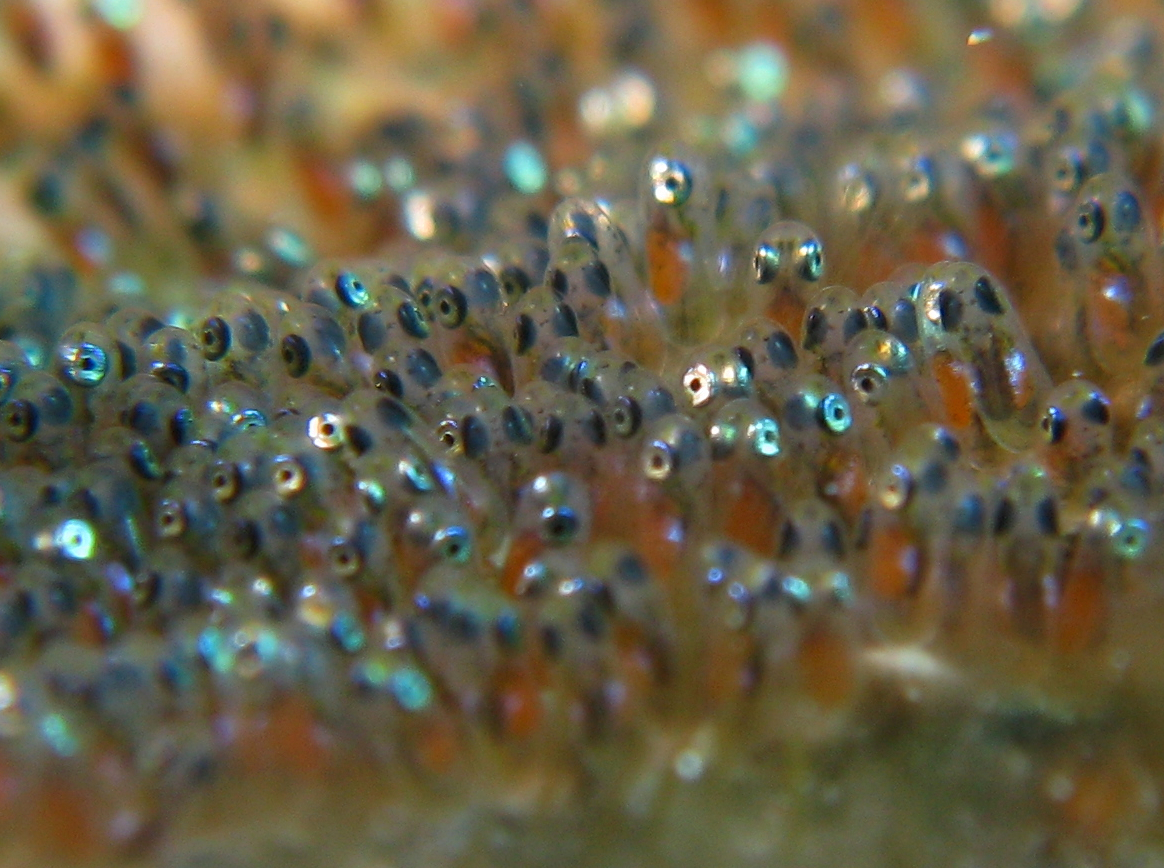|
Marosatherina Ladigesi
The Celebes rainbowfish (''Marosatherina ladigesi'') is a species of sailfin silverside endemic to Sulawesi (formerly known as Celebes) in Indonesia. It is the only known member of its genus. Description Males grow to 6–8 cm, and females to 5–7 cm in length. Their bodies are slender and almost fully transparent with a blue stripe along the sideline. The sexes can be easily distinguished, since males have elongated black dorsal and ventral fins, and are usually a little darker than females. Distribution and habitat ''Marosatherina ladigesi'' is found only near the town of Maros from which the genus name ''Marosatherina'' is derived. Due to ornamental fish business and pollution, their numbers have been dramatically reduced. These fish dwell in streams and estuaries, ranging from fresh to mildly brackish water. They are typically found in areas with high levels of dissolved oxygen. Most of their day is spent hiding among the leaves of plants, where they eat small w ... [...More Info...] [...Related Items...] OR: [Wikipedia] [Google] [Baidu] |
Insect
Insects (from Latin ') are pancrustacean hexapod invertebrates of the class Insecta. They are the largest group within the arthropod phylum. Insects have a chitinous exoskeleton, a three-part body (head, thorax and abdomen), three pairs of jointed legs, compound eyes and one pair of antennae. Their blood is not totally contained in vessels; some circulates in an open cavity known as the haemocoel. Insects are the most diverse group of animals; they include more than a million described species and represent more than half of all known living organisms. The total number of extant species is estimated at between six and ten million; In: potentially over 90% of the animal life forms on Earth are insects. Insects may be found in nearly all environments, although only a small number of species reside in the oceans, which are dominated by another arthropod group, crustaceans, which recent research has indicated insects are nested within. Nearly all insects hatch from eggs ... [...More Info...] [...Related Items...] OR: [Wikipedia] [Google] [Baidu] |
Taxa Named By Ernst Ahl
In biology, a taxon (back-formation from ''taxonomy''; plural taxa) is a group of one or more populations of an organism or organisms seen by taxonomists to form a unit. Although neither is required, a taxon is usually known by a particular name and given a particular ranking, especially if and when it is accepted or becomes established. It is very common, however, for taxonomists to remain at odds over what belongs to a taxon and the criteria used for inclusion. If a taxon is given a formal scientific name, its use is then governed by one of the nomenclature codes specifying which scientific name is correct for a particular grouping. Initial attempts at classifying and ordering organisms (plants and animals) were set forth in Carl Linnaeus's system in ''Systema Naturae'', 10th edition (1758), as well as an unpublished work by Bernard and Antoine Laurent de Jussieu. The idea of a unit-based system of biological classification was first made widely available in 1805 in the int ... [...More Info...] [...Related Items...] OR: [Wikipedia] [Google] [Baidu] |
Freshwater Fish Of Indonesia
Fresh water or freshwater is any naturally occurring liquid or frozen water containing low concentrations of dissolved salts and other total dissolved solids. Although the term specifically excludes seawater and brackish water, it does include non- salty mineral-rich waters such as chalybeate springs. Fresh water may encompass frozen and meltwater in ice sheets, ice caps, glaciers, snowfields and icebergs, natural precipitations such as rainfall, snowfall, hail/ sleet and graupel, and surface runoffs that form inland bodies of water such as wetlands, ponds, lakes, rivers, streams, as well as groundwater contained in aquifers, subterranean rivers and lakes. Fresh water is the water resource that is of the most and immediate use to humans. Water is critical to the survival of all living organisms. Many organisms can thrive on salt water, but the great majority of higher plants and most insects, amphibians, reptiles, mammals and birds need fresh water to survive. Fresh wate ... [...More Info...] [...Related Items...] OR: [Wikipedia] [Google] [Baidu] |
Telmatherininae
The Telmatherininae, the sail-fin silversides are a subfamily of atheriniform fish from the rainbowfish family, the Melanotaeniidae, inhabiting fresh and brackish water. All but the species ''Kalyptatherina helodes'' are restricted to the Indonesian island of Sulawesi, and most are found solely in the Malili Lake system, consisting of Matano Lake Matano ( id, Danau Matano), also known as Matana, is a natural lake in East Luwu Regency, South Sulawesi province, Indonesia. With a depth of , it is the deepest lake in Indonesia (ranked by maximum depth), the 10th deepest lake in the wo ... and Towuti, and the small Lontoa (Wawantoa), Mahalona and Masapi.Gray, S.M., and J.S. McKinnon (2006). ''A comparative description of mating behaviour in the endemic telmatherinid fishes of Sulawesi's Malili Lakes.'' Environmental Biology of Fishes 75: 471–482Herder, F.; J. Schwarzer; J. Pfaender; R.K. Hadiaty; and U.K. Schliewen (2006). Preliminary checklist of sailfin silversides (Tel ... [...More Info...] [...Related Items...] OR: [Wikipedia] [Google] [Baidu] |
Werner Ladiges
Werner may refer to: People * Werner (name), origin of the name and people with this name as surname and given name Fictional characters * Werner (comics), a German comic book character * Werner Von Croy, a fictional character in the ''Tomb Raider'' series * Werner von Strucker, a fictional character in the Marvel Comics universe * Werner, a fictional character in '':File:Darwin's Soldiers image.png, Darwin's Soldiers'' * Werner Ziegler, a fictional character from tv show Better Call Saul Geography *Werner, West Virginia * Mount Werner, a mountain that includes the Steamboat Ski Resort, in the Park Range of Colorado * Werner (crater), a crater in the south-central highlands of the Moon * Werner projection, an equal-area map projection preserving distances along parallels, central meridian and from the North pole Companies * Carsey-Werner, an American television and film production studio * Werner Enterprises, a Nebraska-based trucking company * Werner Co., a manufacturer of ladd ... [...More Info...] [...Related Items...] OR: [Wikipedia] [Google] [Baidu] |
Ichthyologist
Ichthyology is the branch of zoology devoted to the study of fish, including bony fish (Osteichthyes), cartilaginous fish (Chondrichthyes), and jawless fish (Agnatha). According to FishBase, 33,400 species of fish had been described as of October 2016, with approximately 250 new species described each year. Etymology The word is derived from the Greek words wikt:ἰχθύς, ἰχθύς, ''ikhthus'', meaning "fish"; and wikt:-λογία, λογία, ''logia'', meaning "to study". History The study of fish dates from the Upper Paleolithic, Upper Paleolithic Revolution (with the advent of "high culture"). The science of ichthyology was developed in several interconnecting epochs, each with various significant advancements. The study of fish receives its origins from humans' desire to feed, clothe, and equip themselves with useful implements. According to Michael Barton (professor), Michael Barton, a prominent ichthyologist and professor at Centre College, "the earliest ichthyolo ... [...More Info...] [...Related Items...] OR: [Wikipedia] [Google] [Baidu] |
German People
, native_name_lang = de , region1 = , pop1 = 72,650,269 , region2 = , pop2 = 534,000 , region3 = , pop3 = 157,000 3,322,405 , region4 = , pop4 = 21,000 3,000,000 , region5 = , pop5 = 125,000 982,226 , region6 = , pop6 = 900,000 , region7 = , pop7 = 142,000 840,000 , region8 = , pop8 = 9,000 500,000 , region9 = , pop9 = 357,000 , region10 = , pop10 = 310,000 , region11 = , pop11 = 36,000 250,000 , region12 = , pop12 = 25,000 200,000 , region13 = , pop13 = 233,000 , region14 = , pop14 = 211,000 , region15 = , pop15 = 203,000 , region16 = , pop16 = 201,000 , region17 = , pop17 = 101,000 148,00 ... [...More Info...] [...Related Items...] OR: [Wikipedia] [Google] [Baidu] |
Specific Name (zoology)
In zoological nomenclature, the specific name (also specific epithet or species epithet) is the second part (the second name) within the scientific name of a species (a binomen). The first part of the name of a species is the name of the genus or the generic name. The rules and regulations governing the giving of a new species name are explained in the article species description. For example, the scientific name for humans is ''Homo sapiens'', which is the species name, consisting of two names: ''Homo'' is the " generic name" (the name of the genus) and ''sapiens'' is the "specific name". Historically, ''specific name'' referred to the combination of what are now called the generic and specific names. Carl Linnaeus, who formalized binomial nomenclature, made explicit distinctions between specific, generic, and trivial names. The generic name was that of the genus, the first in the binomial, the trivial name was the second name in the binomial, and the specific the proper term fo ... [...More Info...] [...Related Items...] OR: [Wikipedia] [Google] [Baidu] |
Type (biology)
In biology, a type is a particular wiktionary:en:specimen, specimen (or in some cases a group of specimens) of an organism to which the scientific name of that organism is formally attached. In other words, a type is an example that serves to anchor or centralizes the defining features of that particular taxon. In older usage (pre-1900 in botany), a type was a taxon rather than a specimen. A taxon is a scientifically named grouping of organisms with other like organisms, a set (mathematics), set that includes some organisms and excludes others, based on a detailed published description (for example a species description) and on the provision of type material, which is usually available to scientists for examination in a major museum research collection, or similar institution. Type specimen According to a precise set of rules laid down in the International Code of Zoological Nomenclature (ICZN) and the International Code of Nomenclature for algae, fungi, and plants (ICN), the ... [...More Info...] [...Related Items...] OR: [Wikipedia] [Google] [Baidu] |
Egg (biology)
An egg is an organic vessel grown by an animal to carry a possibly fertilized egg cell (a zygote) and to incubate from it an embryo within the egg until the embryo has become an animal fetus that can survive on its own, at which point the animal hatches. Most arthropods such as insects, vertebrates (excluding live-bearing mammals), and mollusks lay eggs, although some, such as scorpions, do not. Reptile eggs, bird eggs, and monotreme eggs are laid out of water and are surrounded by a protective shell, either flexible or inflexible. Eggs laid on land or in nests are usually kept within a warm and favorable temperature range while the embryo grows. When the embryo is adequately developed it hatches, i.e., breaks out of the egg's shell. Some embryos have a temporary egg tooth they use to crack, pip, or break the eggshell or covering. The largest recorded egg is from a whale shark and was in size. Whale shark eggs typically hatch within the mother. At and up to , ... [...More Info...] [...Related Items...] OR: [Wikipedia] [Google] [Baidu] |
Spawning
Spawn is the eggs and sperm released or deposited into water by aquatic animals. As a verb, ''to spawn'' refers to the process of releasing the eggs and sperm, and the act of both sexes is called spawning. Most aquatic animals, except for aquatic mammals and reptiles, reproduce through the process of spawning. Spawn consists of the reproductive cells (gametes) of many aquatic animals, some of which will become fertilized and produce offspring. The process of spawning typically involves females releasing ova (unfertilized eggs) into the water, often in large quantities, while males simultaneously or sequentially release spermatozoa (milt) to fertilize the eggs. Most fish reproduce by spawning, as do most other aquatic animals, including crustaceans such as crabs and shrimps, molluscs such as oysters and squid, echinoderms such as sea urchins and sea cucumbers, amphibians such as frogs and newts, aquatic insects such as mayflies and mosquitoes and corals, which are actually ... [...More Info...] [...Related Items...] OR: [Wikipedia] [Google] [Baidu] |




.jpg)

